How to Make Your Ecommerce Copywriting Sales-Ready
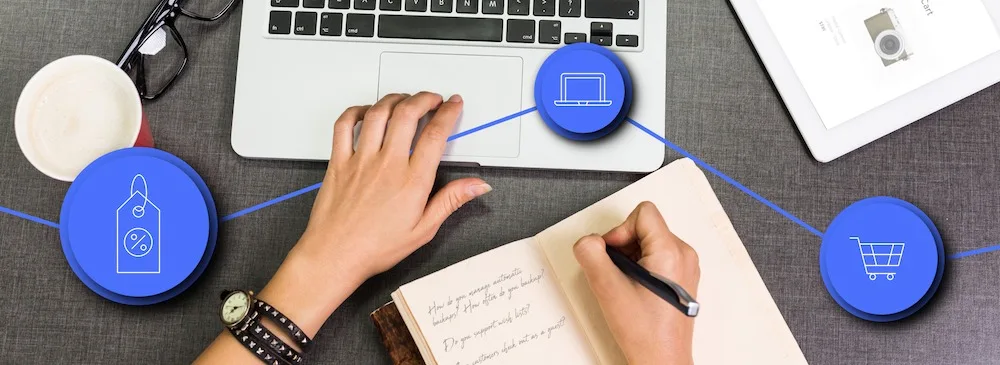

How to Make Your Ecommerce Copywriting Sales-Ready
Get The Print Version
Tired of scrolling? Download a PDF version for easier offline reading and sharing with coworkers.
A link to download the PDF will arrive in your inbox shortly.
There’s a lot of conflicting advice out there when it comes to ecommerce copywriting. Some experts will tell you that you need to keep your landing pages short, and create an urgent sense of “FOMO” to drive sales. Others will tell you that the devil is in the details, and you should go long with your pages to paint a clear picture of why visitors need your product.
The problem is that most of this advice is based on anecdotal experience or decades-old behavioral psychology. There’s no guarantee that any one approach is better than the others, and very little of it is backed up by actual research.
So what’s a data-driven marketer to do? You can try testing different variants of your ecommerce landing pages or online store to see what works best for your audience — but this tends to take a very long time (plus, the test results can be hard to interpret).
To help you figure out what works best for your ecommerce copywriting, our team of data scientists at Unbounce analyzed over 15,000 ecommerce landing pages for the 2020 Conversion Benchmark Report. Here are the questions we set out to answer:
Which words or phrases tend to trigger more sales?
How long should your landing pages actually be?
What does a good (and a not-so-good) conversion rate look like for an ecommerce landing page?
It turns out, there are answers to these questions that don’t require you to just rely on your gut instincts. You can learn what tends to work best based on data trends across the industry as a whole.
Below, we’ll go over the five key takeaways we uncovered with this new machine learning data, and a host of other tips to improve your ecommerce copywriting skills.
What is Ecommerce Copywriting?
Ecommerce copywriting refers to any text or written content you create for an online store. Headlines, category pages, product descriptions, promo offers, landing pages — these are all places where your writing skills can help bring in more sales.
The goal of ecommerce copywriting is to clearly explain the benefits of your products while also helping your online store rank better on search engines. To be successful, you have to be a strong communicator, persuasive with words, promote the voice of your brand, and understand the psychology of what makes a customer purchase.
Take a look at this page from Skullcandy, for example. The ecommerce copywriting here is punchy, speaks directly to the pain points that customers care about most, and directly prompts visitors to click that “Add to Cart” button below.
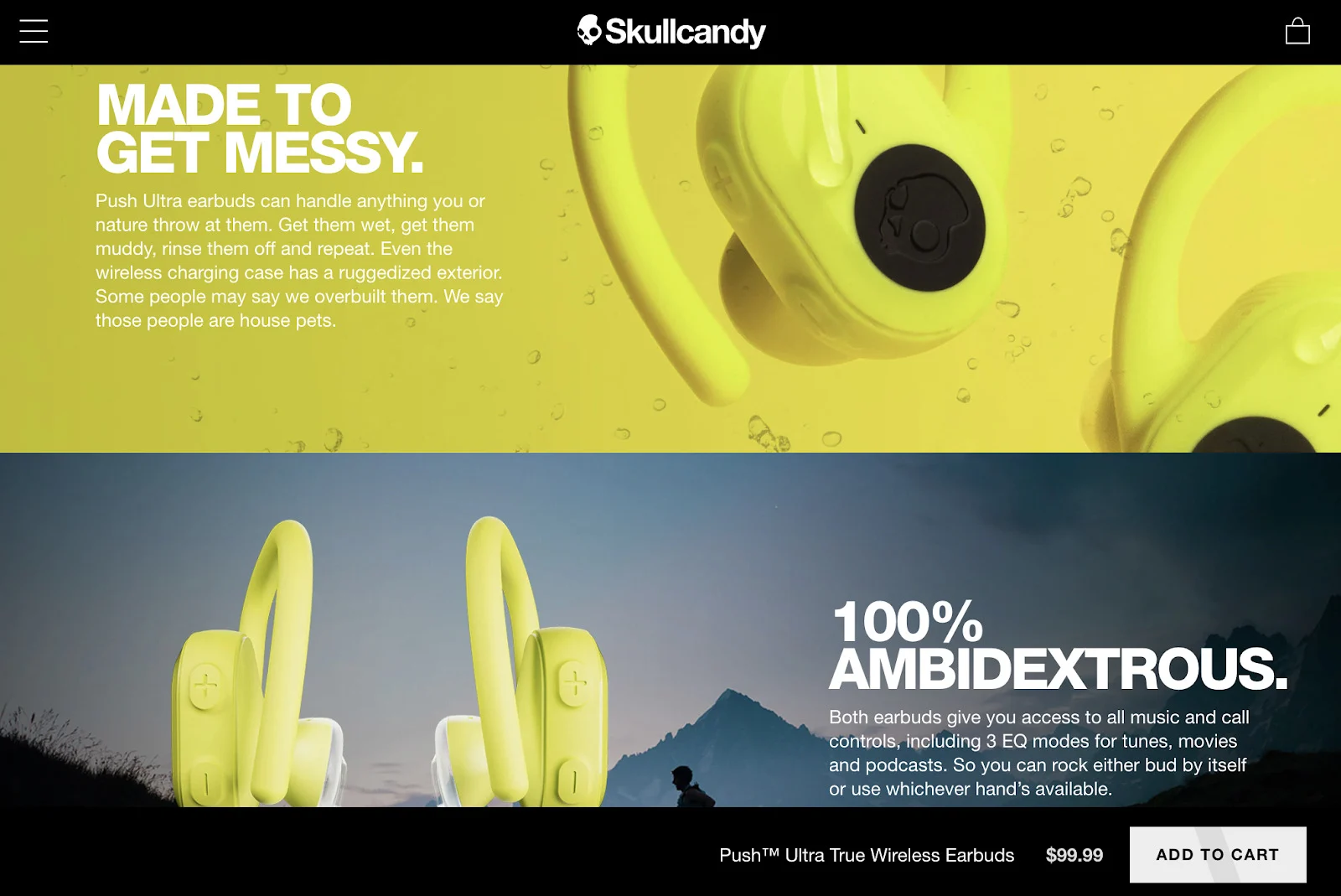
5 Ecommerce Copywriting Statistics Backed By Machine Learning
While they don’t guarantee better performance, statistically speaking this new research from the 2020 Conversion Benchmark Report shows what types of ecommerce copywriting tends to perform best. Keep these insights in mind the next time you’re working on a page for your online store.
1. Write at a middle-school reading level.
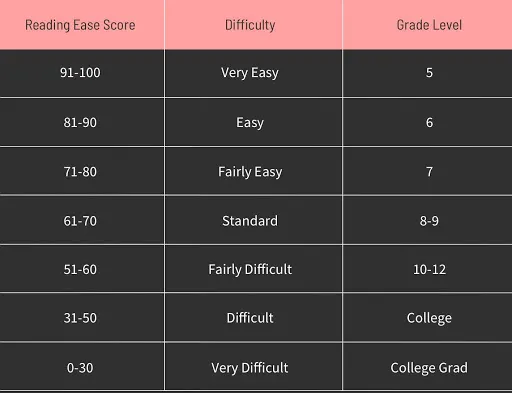
On landing pages, the simpler your ecommerce copywriting is the better chance you’ll have of converting. Our machine learning model found that pages with a Flesch reading ease score (FRES) of 60 and above tend to perform best for ecomm.
Ideally, this means you’ll be writing your copy at a middle school level. No, you don’t have to go back and study Bridge to Terabithia for copy inspiration — simply try to use fewer words in each sentence, and fewer syllables in each word. The difficulty of the text should land somewhere between “Very Easy” and “Standard” on the chart above.
Here’s an example of how you can put this tip into action. The following text appears in the description for a kitchen appliance: “It speeds up cooking by using up to 70% less energy and, above all, produces nutritious healthy food in a convenient and consistent fashion.” But it’s much easier to read as two sentences: “It speeds up cooking by using up to 70% less energy. More importantly, it makes healthy food convenient and consistent.”
You can use an online tool to check the FRES of your ecommerce copywriting, and make these types of adjustments to help improve your score.
2. Test using a click-through CTA.
The data analysis also showed us that using a click-through CTA (like a button that says “Buy Now”) performs almost three times better than getting prospects to fill out a form on the page itself.
This isn’t hugely surprising — it’s much easier to click a button than fill out a form, after all — but it does open up some interesting possibilities for your inbound marketing strategy. Rather than send ad traffic directly to your online store’s product pages or checkout, you could test crafting personalized pre-cart landing pages that put your products in the best spotlight possible (and create a truly great customer experience, first).
Then, once they’re sold on the idea of buying your product (thanks to your spectacular, middle-school level copy) you can direct them to click-through and checkout.
3. Build anticipation in your copy.
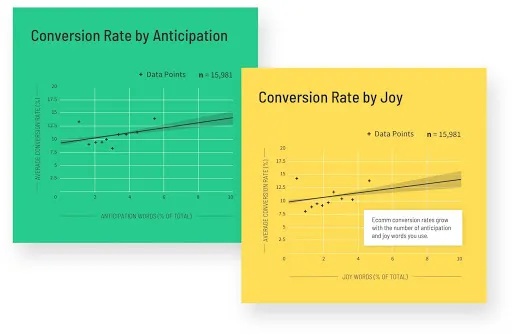
What does a machine know about emotions? Turns out a lot, thanks to our sentiment analysis. We used NRC’s Emotion Lexicon (aka EmoLex) to analyze each page for eight basic emotions: anger, fear, anticipation, trust, surprise, sadness, joy, and disgust.
For ecommerce copywriting, we discovered that the more you use words linked to emotions like anticipation and joy, the more you tend to see higher conversion rates. This means using words like “announcement,” “buzz,” “enjoy,” “improve,” and “recommend” are, well — recommended. (This also helps explain why using promotional strategies like customer discounts and free shipping tend to boost online sales.)
Using positive language that appeals to visitor emotions can get shoppers excited enough to start buying. But at the same time, you want to be careful that you’re not just stuffing these words wherever you can on your page. Instead, try to incorporate these overall sentiments into your style of copywriting.
4. Try to stay under 300 words.
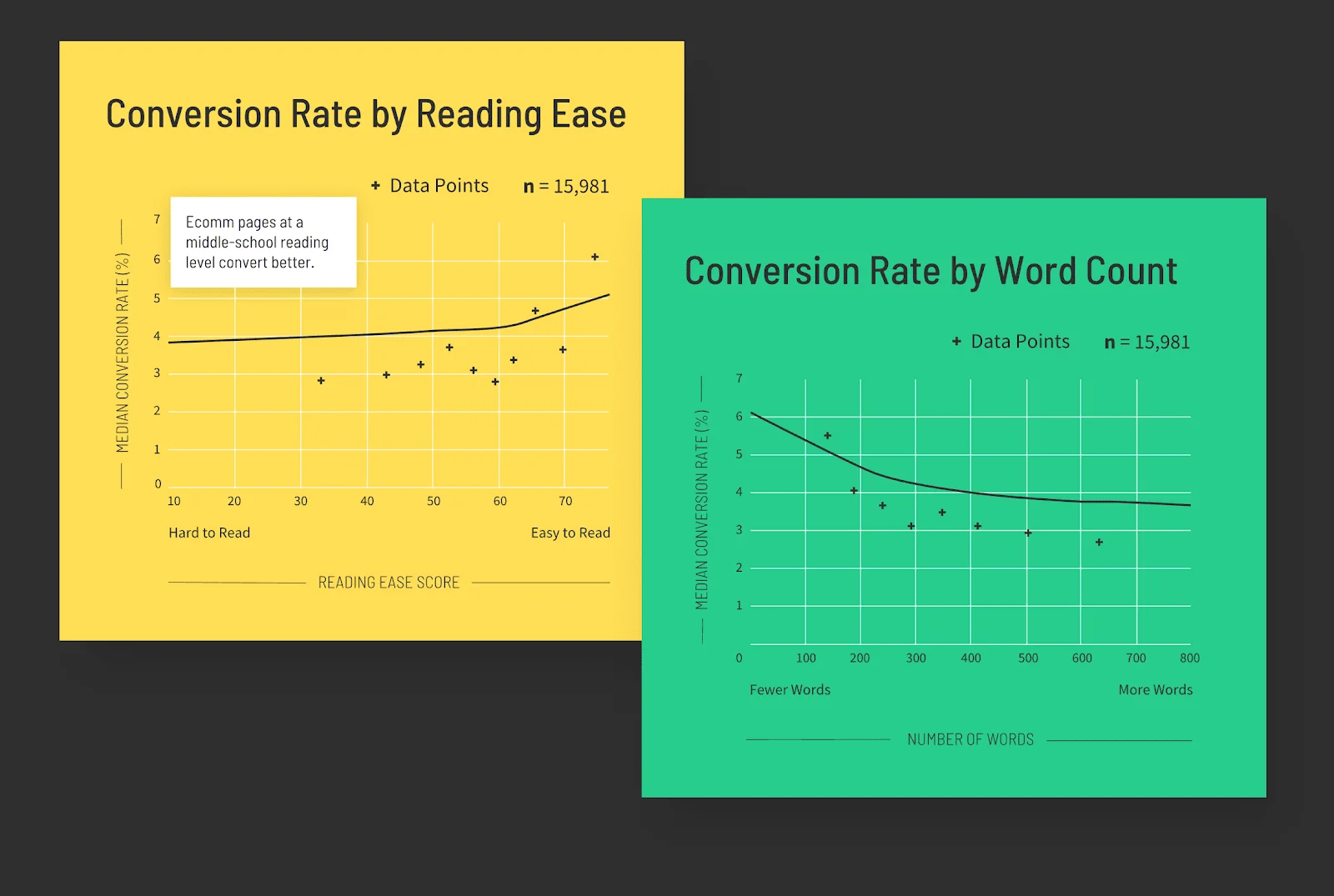
They say brevity is the soul of wit, but perhaps it’s also the soul of ecommerce copywriting. Our regression analysis revealed that ecommerce conversion rates drop pretty consistently as you add more words to your landing page. It seems to reach a tipping point at around the 300 word mark, so you’re probably better off keeping your pages on the shorter side if possible.
Further evidence here: we saw that landing pages for subscription boxes contain half as many words as the ecommerce baseline — and yet, they convert almost 50% better. So maybe take a peek at some of the landing pages for your favorite monthly subscription service and see what other ecommerce copywriting secrets you can learn.
5. Avoid negative language.
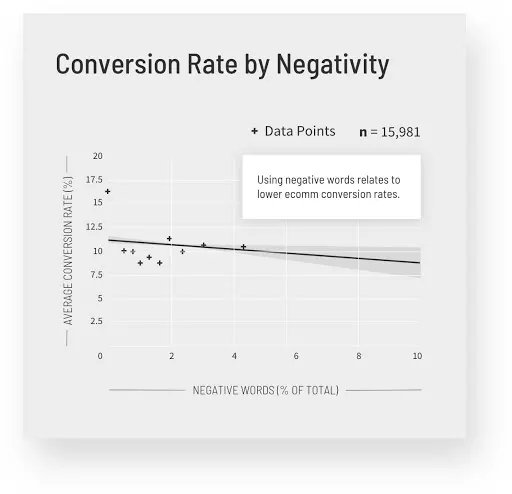
Finally, this last graph shows that adding negativity to your ecommerce copywriting can have a negative impact on your conversion rate. It seems that most customers want to focus on the positive impacts of your product, not dwell on the problems that they’re facing without it.
This is particularly interesting because we saw ecommerce pages used 103% more words associated with the emotion of disgust than the overall industry baseline. So if you’re using the Pain-Agitate-Solve (PAS) formula in your copywriting — maybe go easy on the whole “agitate” part. You don’t want to gross out shoppers before they have a chance to make a purchase.
Pages on Your Ecommerce Site That Need Copywriting
With these statistics in mind, let’s go over some of the different pages on your ecommerce site that need a strong copywriter. Because you can’t just write one landing page and call it a day — there are lots of different places where you can apply these best practices.
1. Product pages.
Your product pages are some of the most important pages of your online store. These are where customers get to learn more about a specific product they’re interested in, and you get the chance to sell them on why they need it. It’s often the last page customers see before they go to checkout — so you want to give them every reason to follow-through with their order.
This means there should be so much more than a two-sentence product description and a list of features. Start by writing about the unique selling proposition that your customers care about most, and then focus on the benefits your product provides. Look for different ways you can tell a story about your product, and highlight some of the real reasons why customers recommend it. Get good at this stuff, and you’ll be able to write product copy that sells itself.
For an example, take a look at this product page for the Jetson Match chair by Duxiana. This is an iconic luxury item, which is why the copywriting focuses on selling the history and significance of the product (rather than showing off the details and dimensions).

2. Category pages.
Often overlooked, category pages also provide a huge opportunity for you to flex your copywriting skills.
Because depending on the design of your ecommerce website, you usually have space at the top or bottom of these pages for at least a line or two of text. Not only is this great for SEO, you can also use it to show visitors why they’re in the right place to shop for these products.
Take a look at this example from Kelty that appears at the bottom of their category page for camping backpacks. They cleverly highlight some of the keywords that visitors might be looking for on this page, and end off with a brand promise that relates back to what shoppers look for in their brand.
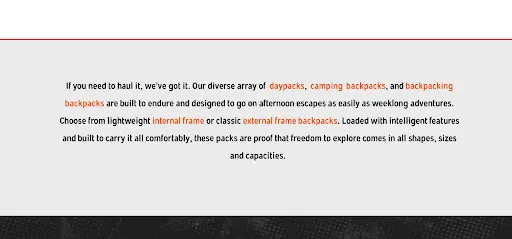
3. About pages.
About pages aren’t so much about selling a particular product as they are about selling the lifestyle of your brand. What makes you different from other online retailers they find on Amazon? Why should customers feel good about choosing to shop with your ecommerce business?
When customers are able to emotionally connect with the mission and values of your brand, they’ll be much more likely to come back to you and purchase again.
That’s why I love this example from the clothing and lingerie store, Natori — rather than have their about page be about the business itself, it instead focuses on Josie Cruz Natori who founded the company. The biography emphasizes her entrepreneurial spirit and humanitarian work, which perfectly aligns with their target audience.

Well-Done Ecommerce Copywriting Has Its Benefits
What happens when you nail your copywriting? Expect to see your online store increase conversions, get more sales, help more customers, rank higher on search engines, and build a stronger brand.
1. More sales.
The words you choose to promote your online business and products absolutely have an impact on your bottom line. This is why so many small businesses are investing in conversion optimization — rather than pay to bring more visitors to your site, you can convince more of your visitors to become paying customers.
2. Informs customers.
In the most basic sense, ecommerce copywriting is about telling customers the important information about your products. You can be strategic about which information you highlight for customers, when to surface it up to them, and how much detail they need.
3. Improves site’s SEO.
To compete with other online stores (like the ones on Amazon and Shopify), you need your ecommerce business to rank higher in the search engines. Weave in select keywords and SEO copywriting to come out on top of your competitors and be first in the minds of your customers.
4. Defines your brand.
Every touchpoint a customer has with your online store helps to define the brand for them, and your copy is a big piece of that. Use high-quality copywriting and a consistent tone to create memorable experiences that visitors will remember long after they checkout.
Common Mistakes Seen in Ecommerce Copywriting
While ecommerce copywriting might seem easy peasy at first glance, there are a lot of pitfalls you can accidentally go down if you’re not careful. Watch out for these common mistakes and errors that first-time writers tend to make.
1. Overuse of adjectives.
Adjectives are like shots of tequila — having a few will go a long way, but having too many is almost always a bad idea. Overuse flowery language in your copywriting and you’ll end up cluttering your sentences, slowing down the pace of your readers, and losing some of the impact of the words themselves.
Instead, try to use a smaller number of powerful and sensory adjectives to paint a clearer picture in the minds of your shoppers. (E.g., “Get out slimy, unsightly grease stains and foul-smelling, gritty spots with this extra magic cleaning powder.”)
2. Lack of personality and flavor.
Nobody likes dry, academic copywriting that just states the facts and sounds like it was written by a robot. You need to add a little zing to your copy so it’s fun to read for shoppers. A human touch.
This is where it helps to have a strong brand personality. If you don’t have one already, start out by asking yourself — if your brand was a person, what would they sound like? Charming, funny, wholesome, trendy, snarky… your personality should reflect your unique brand and your place in the industry.
It helps to imagine an actual celebrity who might represent your brand, and then research the way they speak. See what types of phrases they use and try to bring some of their style into your copywriting.
3. Created in less than 10 minutes.
One of the biggest mistakes you can make with your ecommerce copywriting is thinking you can get it over and done too quickly. This shouldn’t be an afterthought that you slap together off the side of your desk. Be strategic, and carve out some uninterrupted time to work on the copy for every new page of your online store. (Or, alternatively, hire a professional ecommerce copywriter to work with your brand and create the content for you.)
Keep track of how your copy is performing, and try testing new headlines and descriptions to see what works better. Great copywriting doesn’t happen overnight — you can refine it over months, or even years.
4. Word soup and fluff words.
Did you ever struggle to reach a certain word count for a school essay? When I ran into this problem as a student, I used to look for paragraphs that I could “bulk up” by needlessly expanding on points I had already made, or adding in unnecessary context. (Shhh. Don’t tell my high school teachers.)
And while that might fly in academia, it’s something you want to avoid at all costs in ecommerce. Copywriters call this “fluff” or “word soup” because it’s the stuff that doesn’t really add anything of value. And it’s a problem because online readers already have low attention spans — so if you try to fill the page with content that doesn’t really mean anything, they’re probably gonna click away.
5. Focused too much on the product.
I know this might be hard to hear, but most visitors don’t care about you or your products. (*Gasp*) It’s true — the only thing they really care about is themselves, and the problems they’re trying to solve.
When you’re working on the copy for an ecommerce page, you always want to write it from the perspective of your customers. Talk about their pain points, their worries, their fears, and their frustrations. Show empathy and focus on the benefits they will get from your products.
6. Inconsistent tone.
As your online store grows, you may end up working with multiple different team members on your ecommerce copywriting. Watch out to make sure that the language you use all sounds consistent and aligned with your brand personality — no matter who wrote it, or where it’s appearing.
As you scale, I’d recommend putting together brand voice guidelines to show new team members what the tone of voice should sound like. This will help you stay consistent and avoid confusing or upsetting any of your customers.
How to Make Your Ecommerce Copy the Best
The best ecommerce copywriting has a direct and positive impact on sales. Here are some other tips to keep in mind as you go through the writing process for your online store.
1. Know your audience.
It can be tough to nail your copy unless you have a clear understanding of who your audience is and what it is they’re looking for. Customer research is so important to the writing process because it helps you get more specific and focused. (Which is also why customer testimonials are a goldmine for ecommerce copywriters.)
If you haven’t already done so, try creating buyer personas to represent your ideal customers. You can use these profiles to target specific segments of your customer base, and speak directly to their beliefs, opinions, interests, and motivations.
For example, take a look at this category page for Bliss vegan skincare products. The copy calls out how important this is for animals (or “furry friends”) around the world and celebrates your decision to buy cruelty-free products right at the top.
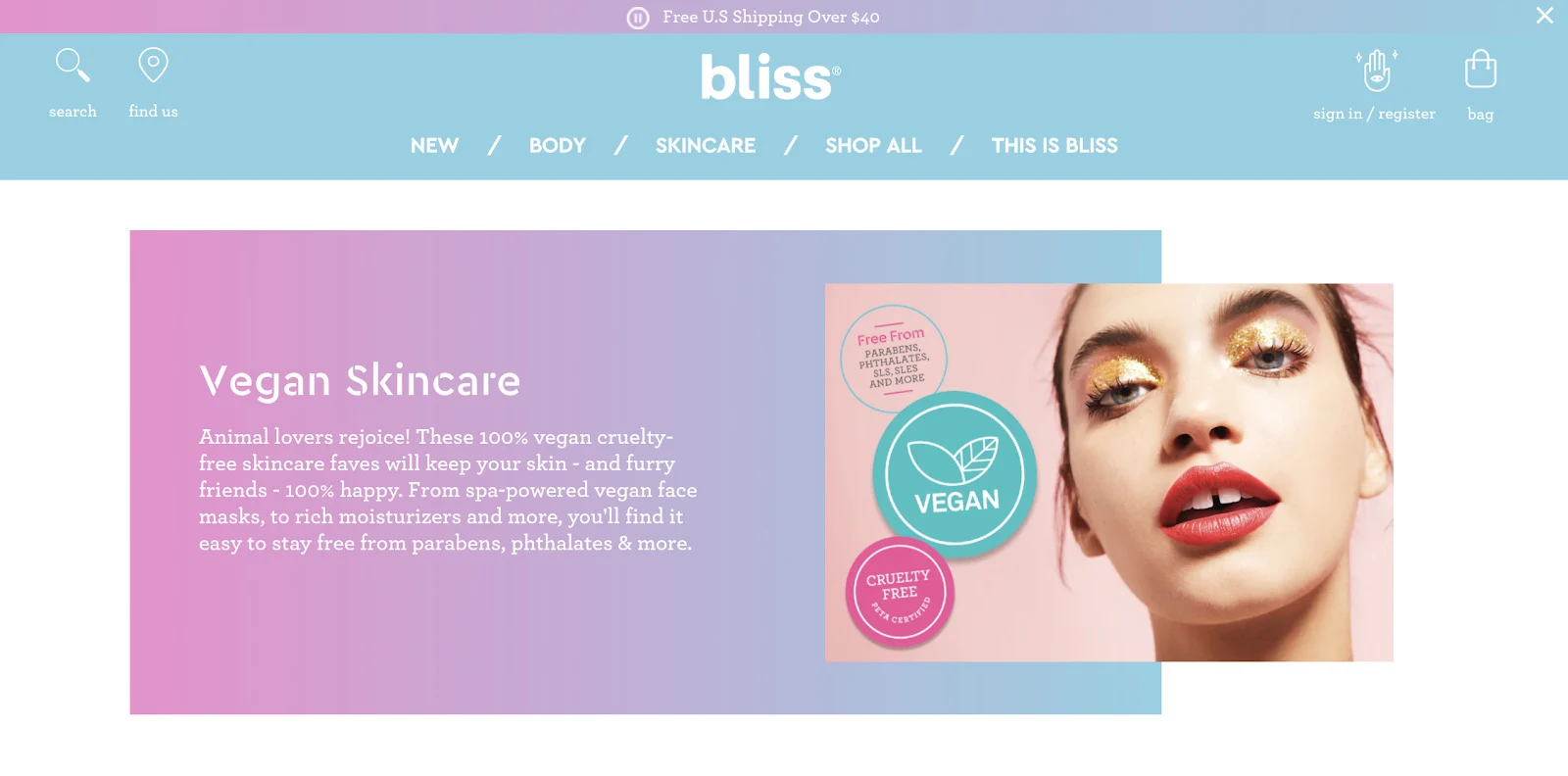
2. Tell an interesting story.
The framework of a story can help to hook shoppers in a deeper way, so they buy from your brand more than one time. That’s because people love a great story. It’s human nature.
But what types of stories can you tell with your ecommerce copywriting? You can apply this simple formula to almost any product or offering:
Your hero of the story is the shopper. (The protagonist.)
They have a problem they need to solve. (The conflict.)
They have struggled with trying to solve this. (The rising action.)
Now—there is a solution. (The climax.)
And they’ll live happily ever after. (The resolution.)
There are other storytelling models and formulas you can apply to your ecommerce copywriting, too. Find the right one for your audience, and you’ll be able to form a stronger emotional bond with them that lasts much longer.
3. Avoid wordy sentences.
As we mentioned above, the harder your copy is to read, the less likely it is to convert. That’s why wordy sentences — especially the ones that use business jargon — are better left on the cutting room floor.
Not sure if your copy is too difficult? Try reading it out loud to a colleague or partner. Sometimes, we get so used to reading things quickly in our heads that we don’t realize how challenging they can be for folks who read the copy for the first time.
4. Focus on benefits.
Product features tend to be pretty boring. Most folks won’t care if your electric toothbrush has a lithium-ion battery, three types of thistles, or proprietary pulse technology. (Whatever that means.) All they want to know is how those features will actually benefit their lives.
Check out how Bon Bon Bon writes about their Sugar Chai Crunch Tape, for example. They don’t just talk about what ingredients are inside this unique chocolate treat — the copy gets into the feeling you’ll have when you bite into it, and how much your crush will appreciate such as a thoughtful gift. Super smart and benefits-focused.
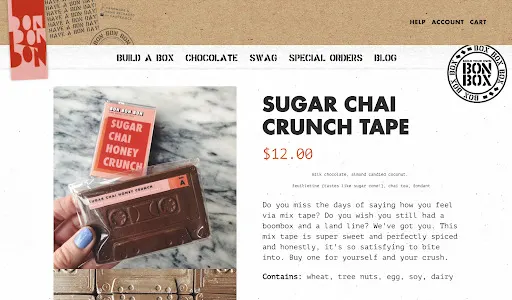
5. Use action words.
If you want shoppers to take action, it makes sense that you should include action words in your copy. What’re action words? In copywriting, this is any language you use to ask visitors to actually do something on the page. (So, like, “Buy Now.”)
You can sprinkle these words and phrases in more places than just your buttons, too. Try starting sentences with verbs that ask visitors to take action, so they feel more engaged with the copy. I love how The Mountain uses active language to promote their face masks on their homepage, for example. (“Be safe. Be stylish.”)

6. Integrate keywords in the copy.
While your primary audience for your copywriting should always be actual shoppers, you’re also writing copy for an entirely different audience: search engines. With each page, you have an opportunity to target specific keywords that will get you to the top of Google search results pages and bring in more organic traffic.
You can use the Google Ads Keyword Planner for some basic research, as well as other tools like Ahrefs, Answer the Public, and Keyword Surfer. You may also want to pair your ecommerce website with a strong content marketing strategy (like a blog) to bring in more visitors from search engines.
7. Use bullet points for product pages.
A giant paragraph with a ton of text can be pretty intimidating for shoppers just looking to purchase a pair of sneakers. Instead, try organizing your copy into bullet points for easier reading and improved scannability. This is especially useful for when you have a big list of product details that you want to showcase.
Some other advantages of bullet points…
They help you group ideas together into buckets, cutting down on redundant text.
They’re more visually appealing, adding whitespace and breathing room to your page.
They’re easier to read on mobile devices, providing a better user experience than a big block of text that’ll take up the entire screen.
Keep Testing and Improving Your Copy
Machine learning has come a long way — but a robot still can’t write a landing page half as well as you can. Combine your marketing know-how with the statistics above to give your ecommerce copywriting a boost of conversion intelligence.
Keep in mind your unique audience and what products your online store is selling. You can use this data as inspiration to test new landing page variants and see how they impact your ecommerce metrics and customer analytics.
And if you’re interested in learning more, you can also check out the 2020 Conversion Benchmark Report. There are more ecommerce insights in the full report (as well as data on 15 other industries) and benchmarks to show you what counts as a good conversion rate on your landing pages.

Luke Bailey is a copywriter at Unbounce, the leading landing page platform. You can use the Unbounce drag-and-drop builder to convert more of your visitors into leads, sales, and customers with conversion intelligence.


